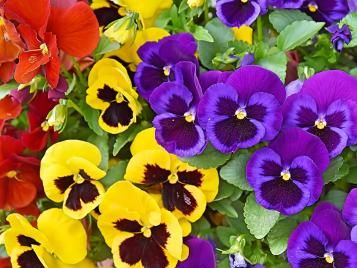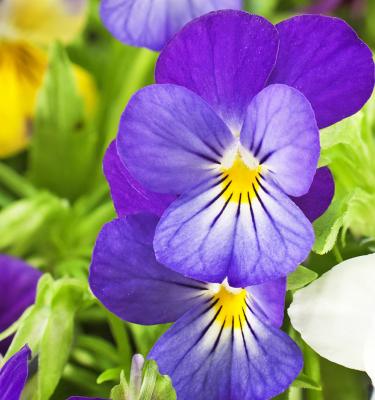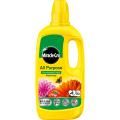There are numerous species and varieties of Viola that are fabulous garden plants. These range from the small-flowers of Viola tricolor, commonly known as heartsease, through numerous types of violets - including sweet violets or English violets (Viola odorata) and Parma violets - all the way through to the large flowers of pansies (usually referred to as Viola x wittrockiana).
Nearly all violas are reliably hardy and form low-growing mats of evergreen foliage that is excellent as ground cover. Most violas have a long flowering period in spring and summer - and the winter-flowering pansies will provide excellent garden colour throughout the colder months of the year and well into late spring.
Although most species are perennial and are grown for many years, pansies and heartsease are usually grown as an annual or biennial bedding plant, and disposed of after flowering. Put the old plants on the compost heap.
How to grow violas
Cultivation
For best results, violas should be grown either in full sun or light or dappled shade. They prefer a fertile soil enriched with lots of organic matter, which holds plenty of moisture in spring and summer, doesn’t dry out or become waterlogged. Add a general or high potash granular feed to the soil before planting out.
Sowing violas
Violas and pansies are easy to grow from seed. Sow seeds either in seed trays, cell trays or pots of good seed sowing compost indoors at a temperature of around 15-18°C (60-65°F). Make sure the seeds are well covered as they dislike light. High and widely fluctuating temperatures and fluctuating moisture levels can cause failure.
Prick out the seedlings individually when they are large enough to handle, either into seed trays or, better still, cell trays or 7.5-9cm (3-3.5in) pots.
Summer bedding plants: Sow February to March.
Winter bedding plants: Sow from May to July.

Planting violas
For bold displays, plant out around 15-23cm (6-9in) apart.
If you don’t grow your own from seed, plug plants and seedlings are available from mail order seed companies and larger, ready-to-plant plants are available from garden centres.
To ensure colourful winter displays, it is important to grow reliably hardy, winter-flowering varieties and plant them out before the weather turns too cold in autumn; September or early October is the best time. If the plants are too small or haven’t produced any flower buds by the time you plant out, they are unlikely to produce a reliable display throughout the winter months, but will come into flower when the weather warms up in spring.
Growing violas from cuttings
It is possible to propagate most violas from stem cuttings taken in summer from the current year’s non-flowering shoots.
Take cuttings around 5-7.5cm (2-3in) long, cutting just below a leaf joint, or node. Remove the leaves from the lower half to two-thirds of the stem and insert in pots of a suitable cuttings compost to the base of the leaves, spacing cuttings so the leaves don’t touch. Place the pot in a plastic bag or in a propagator and place somewhere warm, with good light, but out of direct sunlight to root.
Pot up plants individually once they have rooted and grow them on until they are big enough to plant out.
Suggested planting locations and garden types
Flower beds and borders, patios, containers, city and courtyard gardens, cottage and informal gardens, bedding displays, ground cover.
How to care for violas
Keep the soil or compost moist, especially when plants are flowering. Regular liquid feeds will help prolong the flowering period.
Regularly deadhead plants, removing the developing seedpod to prolong flowering.
After flowering, cut back perennial violas to keep them compact. Trimming over pansies after flowering and giving them a liquid feed, may promote further flushes of flowers. Don’t grow pansies in the same soil or compost year after year as this can lead to a build-up of soil problems - sometimes called ‘pansy sickness’ - which cause the plants to fail.
| Flowering season(s) | Spring, Summer, Autumn, Winter |
|---|---|
| Foliage season(s) | Spring, Summer, Autumn, Winter |
| Sunlight | Partial shade, Full sun |
| Soil type | Chalky, Clay, Loamy, Sandy |
| Soil pH | Neutral |
| Soil moisture | Moist but well-drained |
| Ultimate height | 15-23cm (6-9in) |
| Ultimate spread | 15-23cm (6-9in) |
| Time to ultimate height | 3-4 months |









